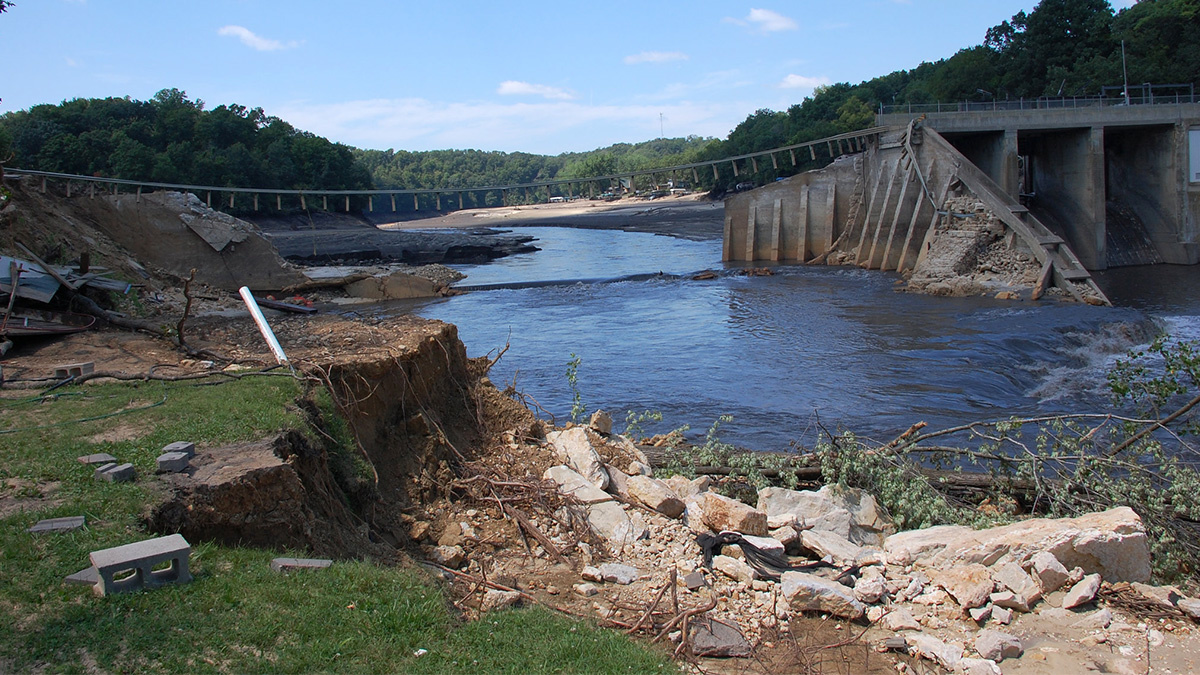
More Than 1,600 Hazardous Dams Pose Life-Threatening Risk to Americans

The Lake Delhi Dam in Iowa failed in 2010. VCU Capital News Service / Josh deBerge / FEMA
At least 1,688 dams across the U.S. are in such a hazardous condition that, if they fail, could force life-threatening floods on nearby homes, businesses, infrastructure or entire communities, according to an in-depth analysis of public records conducted by the the Associated Press.
Over the course of two years, the publication reviewed data and reports obtained through open record laws to find that at least 1,688 high-hazard dams rated in poor or unsatisfactory condition as of last year across 44 states and Puerto Rico. However, the AP says that the actual number is likely higher.
“Some states declined to provide condition ratings for their dams, claiming exemptions to public record requests. Others simply haven’t rated all their dams due to lack of funding, staffing, or authority to do so,” reports the outlet.
There are more than 90,000 dams across the nation with a large proportion more than 50 years old, according to the National Inventory of Dams database. Between 1850 and 2017, nearly 3,500 fatalities have occurred as a result of 64 dam failures in the U.S. – or just 3.9 percent, notes a report conducted by the National Performance of Dams Program (NPDP) at Stanford University. Regulatory requirements and infrastructure investments have largely contributed to a reduction in dam failures, yet around 1,000 dams have failed in the last four decades, resulting in the deaths of 34 people, reports the AP.
“There are thousands of people in this country that are living downstream from dams that are probably considered deficient given current safety standards,” Mark Ogden, Association of State Dam Safety Officials technical specialist, told the publication. An estimate suggests it may take billion to bring the more than 90,000 dams up-to-date around the country.
“Most people have no clue about the vulnerabilities when they live downstream from these private dams,” said Federal Emergency Management Agency former administrator Craig Fugate. “When they fail, they don’t fail without warning. They just fail, and suddenly you can find yourself in a situation where you have a wall of water and debris racing toward your house with very little time, if any, to get out.”
Since 1980, there has been an average of 24 dam failures each year, according to the NPDP. In the U.S., dams are rated as unsatisfactory, poor, fair, or satisfactory but vary by state and individual inspectors. A summary compiled by Weather.com found that Georgia had the most high-hazard dams in unsatisfactory or poor condition with nearly 200 across the state followed by North Carolina (168), Pennsylvania (145), Mississippi (131), Ohio (124), Indiana (65), New York (48), Massachusetts (39), Kansas (26), Colorado (24), Wyoming (18), Arizona (16) and Montana (11).
- Multiple Dam Failures Aggravate Dangerous Conditions in Flood ...
- Faulty Dam in California Almost Floods Area, Might Still – the paper
- 'Flawed' dam may threaten St. Louis area | ksdk.com
- Minute by minute: What if Oroville Dam's spillway had failed one ...
- Engineers up failure risk for dam protecting Disneyland, dozens of ...

 233k
233k  41k
41k  Subscribe
Subscribe 